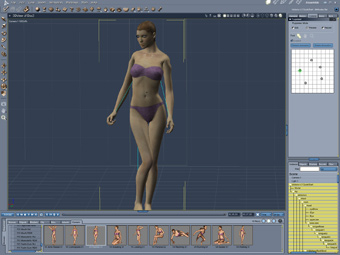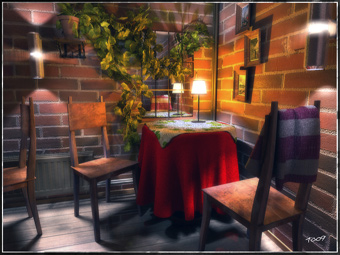An affordable tool with advanced lighting tools and a new physics engine

Puppeteer works by interpolating between saved character poses. In theory, you can move a character from pose to pose in a sort of pre-animation choreography storyboarding. But there isn’t much that Puppeteer does that can’t already be done in the existing timeline with keys and animation clips, making Puppeteer redundant. To make things even worse, it isn’t very stable. In the Windows test platform Puppeteer consistently made Carrara crash. In my opinion, DAZ would better serve its users by developing character animations tools that actually work rather than gimmicky tools like Puppeteer.
Bullet Hits the Mark
On a much brighter note the popular, open-source physics engine Bullet has been integrated into Carrara. Bullet, seen at top, makes it very easy to animate ultra-realistic physics simulations in Carrara, and it is a huge improvement over Carrara’s native physics engine. The rigid body solver produces simulations, like a bowling ball knocking down pins, and the soft body solver simulates actions like a flag waving in the wind. You can use both solvers together to produce layers of very realistic simulations. Though I found some minor issues with the integration of Bullet and Carrara, overall Bullet is easy to use and better yet, produces simulations you can view and edit in real time.
With this release Carrara finally joins the ranks of 3D applications that can simulate realistic lighting based on IES profiles. IES profiles provide precise photometric information about the illumination patterns of specific light types. For instance, an IES profile for a 40-watt compact incandescent bulb would produce different lighting than a profile for a recessed 70-watt candescent bulb. Architectural and engineering illustrators and animators use EIS profiles to produce realistic lighting for their walkthroughs and renders all the time.

There are also a number of improvements to Carrara’s advanced lighting tools in this release, such as barn doors for spotlights, options for negative lighting, and a new “God Ray” option that simulates atmospheric lighting through clouds. Carrara’s sophisticated tools, from previous versions, include support for HDRI, global illumination and subsurface scattering.
To take advantage of ever-increasing computing power and let users access more RAM, Carrara 8 ships in 32-bit and 64-bit versions for both Windows and Mac OS platforms. Carrara 8 also multi-threads many computing-intensive processes; simply put, that means Carrara can use all available processors to dramatically speed up rendering and global illumination, for example. Another nice feature in Carrara 8 Pro is the improved COLLADA and FBX interoperability, making it much easier to exchange data between 3D applications or export it to game engines.
Modeling Tools
While Carrara features an impressive polygonal and subdivision surfaces modeler, it hasn’t been updated in the last few releases. No luck this time, either. The only modeling improvement is the ability to edit DAZ characters in any pose. DAZ better update its modeling tools soon; they are in danger of becoming outdated.
Criticisms aside, Carrara has some top-notch modeling tools that work exceptionally well, including environmental modelers that rival anything found in dedicated programs like Vue. Though not technically part of the modeling tools (but closely related), it is also worth mentioning that Carrara features a production-level 3D painting system.
If you don’t have a huge budget to spend, Carrara is still an affordable alternative that delivers advanced modeling, lighting, animation and rendering tools. The performance improvements, the Bullet physics engine, the environmental modeler and the new lighting updates inside this release make it even more of a great deal for the price.












I’m considering upgrading from Carrara 6 pro to 8 standard. I wish I could find some good reviews on the standard edition as pro is far out of my reach.